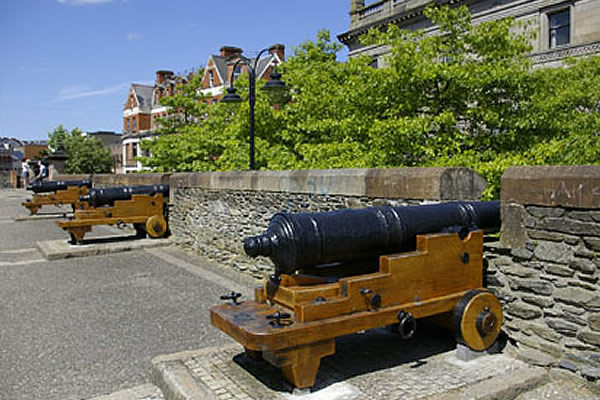Cannons at Londonderry

Horsmonden built cannons on the ramparts of the siege city
We have recently had it confirmed that there are probably three John Browne cannons and one Thomas Johnson cannon amongst the recently restored 16th and 17th century cannons at Londonderry (aka Derry) in Northern Ireland. Londonderry claims the largest collection of cannons in Europe whose origins are known precisely. Many of them thundered in anger over the two seventeenth century sieges.
In 2005 Derry City Council decided to restore the surviving 24 cannon and under expert supervision and often by hand, craftsmen, cleared the barrels of centuries of rubbish, stripped off layers of paint and corrosion and bathed, sponged and waxed the cannon back to their former glory. The cannon are displayed throughout the City Walls.
Thomas Johnson Demi-Culverin
A gun designated ‘C12’ is a demi-culverin of 10ft dating to 1590 and bearing the mark of Thomas Johnson, Queen’s founder of iron ordnance. Read more…
John Browne Demi-Culverin
Looking for information on these demi-culverin cannons ‘G1’, ‘C3’ and ‘C9’. We’ll create dedicated pages once we have some.
Learn more: Londonderry
Londonderry is the only remaining completely intact walled city in the whole of Ireland and one of the finest examples of a walled city in Europe.
The Walls were built during the period 1613-1619 by The Honourable The Irish Society as defences for early 17th century settlers from England and Scotland. The Walls, which are approximately 1 mile in circumference and which vary in height and width between 12 and 35 feet, are completely intact and form a walkway around the inner city.
It is one of the few cities in Europe that never saw its fortifications breached, withstanding several sieges including one in 1689 which lasted 105 days.
Learn more: 17th Century Londonderry
During the 1640s, the city suffered in the Wars of the Three Kingdoms, which began with the Irish Rebellion of 1641, with a failed attack on the city by Gaelic Irish insurgents. In 1649 the city and its garrison, which supported the republican Parliament in London, were besieged by Scottish Presbyterian forces loyal to King Charles I. The Parliamentarians besieged in Londonderry were relieved by a strange alliance of Roundhead troops under George Monck and the Irish Catholic general Owen Roe O’Neill. These temporary allies were soon fighting each other again however, after the landing in Ireland of the New Model Army in 1649. The war in Ulster was finally brought to an end when the Parliamentarians crushed the Irish Catholic Ulster army at the battle of Scarrifholis in nearby Donegal in 1650.
During the Glorious Revolution, only Londonderry and nearby Enniskillen had a Protestant garrison by November 1688. An army of around 1,200 men, mostly ‘Redshanks’ (Highlanders), under Alexander Macdonnell, 3rd Earl of Antrim, was slowly organised (they set out on the week William of Orange landed in England). When they arrived on 7 December 1688 the gates were closed against them and the Siege of Londonderry began.
In April 1689, King James came to the city and summoned it to surrender. The King was rebuffed and the siege lasted until the end of July with the arrival of a relief ship.
Useful links
The Great Guns Like Thunder: The Cannon from the City of Derry
